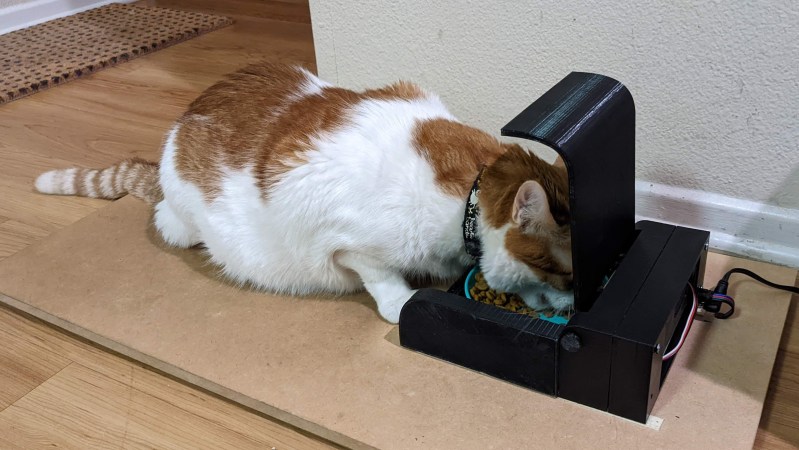If you have more than one pet, you may know how hard it is to tell how much each furry friend is eating. If you introduce prescription foods, then this minor annoyance can have a major impact on your pet’s health. Facing this dilemma, [tomasdiazwahl] set out to make a pet feeder that feeds his pets exactly what they need when they approach the feeder.
Using the ever-popular Arduino Uno, the feeder is connected to a platform that uses load cells to detect the pet’s weight. The weight data is then used to identify which animal is looking for food. Once the pet is identified, the correct food bowl opens. It seems this prototype only has one food chamber to keep unauthorized pets from eating the special food, but the basic idea should be extensible to two or more chambers. While some existing solutions read the pet’s microchip or NFC collars to determine who’s at the feeder, [tomasdiazwahl] decided against these given the fickleness of trying to reliably get a reader at the correct position relative to the pet. As long as you don’t have multiple pets with the same weight, it should work just fine.
This project has a nice mix of woodworking, 3D printing, and electronics showing what can be accomplished when you aren’t afraid to mix techniques. We also really appreciate that [Tomasdiazwahl] spent the extra time to include a testing procedure and safety mechanism into the project. Designing a device to improve your pet’s health shouldn’t come with a safety risk!
This isn’t the first cat feeder we’ve covered that uses weight to tell the difference between the pets, and if you want a simpler project to start with, check out this Simple Auger Pet Feeder.
















Do folks here know if you can leave a large load, constantly, on load cells without damaging them?
About 100lbs (~43kg) would be the constant tare weight, and the additional weight, to measure, would be the weight of an adult human. So, ~25lbs (~10.5kg) on each cell, all the time.
I was thinking these (price is right, and capacity is sufficient when spread across four on a level surface):
https://www.sparkfun.com/products/10245
Load cells are designed to deform elastically so that they get a nice linear measurement that is repeatable. You will get a change in output when a load is left on the scale (creep on the datasheet). In that application I’d be worried about the instantaneous asymmetric load when someone steps on your load platform exceeding one of your load cells. The load may not be applied to multiple load cells equally.
However if you look at the datasheet for the product you referenced, the creep is less than 0.3% after three minutes and probably won’t change much more.
Well done – thanks for sharing this project. We have three cats (all significantly different in weight), and one needs a specific food due to a medical issue. I’ll definitely check this out!
I don’t own a cat, but does the lid close after the pet leaves to prevent food odors escaping? Also, “When it comes to cat odor complaints, chances are, the litter box is the source.” Anyone made something like this with an unrolling cover on tracks for a litter box?
My front porch possum would have the project open in minutes at most.
You can tell when he’s been there, not a single scrap of cat food left. Cat’s always leave bits.
Best thing about outdoor cats, no litter boxes. Also they don’t spend decades sitting sadly on the windowsill dreaming of freedom. Also pest control around fruit trees.
Where I live it’s frowned upon to have an outdoor cat, and even banned in some suburbs. They are just too effective at killing native wildlife and birds.
I wonder if simple colorimetry could help distinguish pets of too-similar weight; perhaps using a TCS3472 or similar sensor.
This could be very useful for pest management. Pets’ food bowls can be a difficult to control food source for mice.
Aowsom
Get quality food for pets and animal. Do you need pet food suggestions and recommendations? Click here 👉https://nzaffiliates.com/best-pet-food/